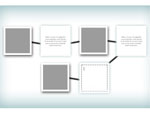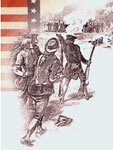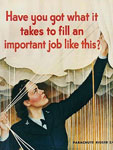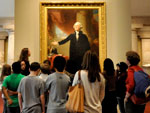Joe Jelen on Document Cameras
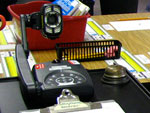

A document camera makes a great addition to a history classroom with a video projector or TV. A document camera captures anything under its lens and projects it on the screen. While this technology has been around for a few years, I have noticed it has been a little slow to catch on for a variety of reasons.
Some teachers may be hesitant to embrace the document camera because they believe it to simply be a glorified overhead projector. The document camera beats the old overhead projector in many ways, the first being that the document camera does not require one to make transparencies. A teacher can project artifacts, photos, worksheets, and anything else that can fit under the camera lens. In addition, students are better able to see the image produced by a document camera as it is much brighter and clearer than the image produced by the overhead projector. Best of all, you no longer leave school covered in overhead marker!
The cost of the document camera may also make this teaching tool seem out of the reach of many teachers and districts in these lean budget years.
While document cameras range in price from $200 to $2,000, this should not preclude one from having their own document camera. You can find a used document camera on eBay or a surplus property store for under $100. I bought mine at one such surplus property store, associated with the
University of Maryland, for $25. Another option is to make a document camera yourself using a webcam and available USB port. The only drawback to this setup is you have to be able to load software on your computer attached to the video projector in your classroom. A ready-made version of this runs about $69. It is also possible to obtain grant money for document cameras from places like DonorsChoose.
Once you have your document camera installation is straightforward.  Some document cameras come with a freeze image button which is a great feature to capture a page in a book or map that might be difficult to hold in place. If the document camera does not have this feature, you can hook up the document camera directly to the video projector, which often has the ability to freeze an image. If your document camera is not one that hooks up to your computer via USB, you can also set up the document camera directly to your projector. This allows you to toggle between the image on your computer screen (assuming it too is attached to your video projector) and the image from your document camera. You can also connect most document cameras to a television using an S-video cable or component video cable. It should be noted, however, that the clarity is not as crisp when using the S-video cable or component video cable compared to using a VGA or DVI connection.
Some document cameras come with a freeze image button which is a great feature to capture a page in a book or map that might be difficult to hold in place. If the document camera does not have this feature, you can hook up the document camera directly to the video projector, which often has the ability to freeze an image. If your document camera is not one that hooks up to your computer via USB, you can also set up the document camera directly to your projector. This allows you to toggle between the image on your computer screen (assuming it too is attached to your video projector) and the image from your document camera. You can also connect most document cameras to a television using an S-video cable or component video cable. It should be noted, however, that the clarity is not as crisp when using the S-video cable or component video cable compared to using a VGA or DVI connection.
The document camera has vast instructional possibilities. I have used my document camera every day in my history classroom. One of the benefits of having a document camera in a history classroom is having the ability to analyze primary sources together as a class. I am able to zoom in on important components of a photograph or text and can invite students to the document camera to annotate pictures or text without bulky markers or transparencies. I am also able to share maps in books easily with students, in color. Students are able to share work they have created immediately with the class without having to scan an image or make a transparency of the document.
This means that jigsaw activities work very efficiently, with each group able to share what they have written on nothing larger than a worksheet. Collectively, classes have created essay outlines and timelines together. The document camera allows students to share storybooks they have created, projected large enough for the class to see. From a classroom management perspective, the document camera allows me to easily show students the worksheet we are working on or the question I want them to focus on. I am also able to place my stopwatch under the camera to show students how much longer they have to complete a task. Finally, my favorite use of the document camera is allowing me to spotlight and share exemplar student work. I am able to give specific praise to a well-written essay or project.
I hope you are able to get your hands on a document camera and share your tips and tricks with others. You can find product reviews for document cameras in this article from Scholastic.
Looking for more suggestions for creative overhead, smartboard, or document camera activities? Jelen demonstrates a technique for introducing students to visual primary sources in our video "Zoom-in Inquiry".
From MP3 players to Skype, our Tech for Teachers section examines other tools appropriate for classroom use.
